Zeyu Tang
Position: Mechanistic Interpretability Should Prioritize Feature Consistency in SAEs
May 26, 2025Abstract:Sparse Autoencoders (SAEs) are a prominent tool in mechanistic interpretability (MI) for decomposing neural network activations into interpretable features. However, the aspiration to identify a canonical set of features is challenged by the observed inconsistency of learned SAE features across different training runs, undermining the reliability and efficiency of MI research. This position paper argues that mechanistic interpretability should prioritize feature consistency in SAEs -- the reliable convergence to equivalent feature sets across independent runs. We propose using the Pairwise Dictionary Mean Correlation Coefficient (PW-MCC) as a practical metric to operationalize consistency and demonstrate that high levels are achievable (0.80 for TopK SAEs on LLM activations) with appropriate architectural choices. Our contributions include detailing the benefits of prioritizing consistency; providing theoretical grounding and synthetic validation using a model organism, which verifies PW-MCC as a reliable proxy for ground-truth recovery; and extending these findings to real-world LLM data, where high feature consistency strongly correlates with the semantic similarity of learned feature explanations. We call for a community-wide shift towards systematically measuring feature consistency to foster robust cumulative progress in MI.
When Selection Meets Intervention: Additional Complexities in Causal Discovery
Mar 10, 2025Abstract:We address the common yet often-overlooked selection bias in interventional studies, where subjects are selectively enrolled into experiments. For instance, participants in a drug trial are usually patients of the relevant disease; A/B tests on mobile applications target existing users only, and gene perturbation studies typically focus on specific cell types, such as cancer cells. Ignoring this bias leads to incorrect causal discovery results. Even when recognized, the existing paradigm for interventional causal discovery still fails to address it. This is because subtle differences in when and where interventions happen can lead to significantly different statistical patterns. We capture this dynamic by introducing a graphical model that explicitly accounts for both the observed world (where interventions are applied) and the counterfactual world (where selection occurs while interventions have not been applied). We characterize the Markov property of the model, and propose a provably sound algorithm to identify causal relations as well as selection mechanisms up to the equivalence class, from data with soft interventions and unknown targets. Through synthetic and real-world experiments, we demonstrate that our algorithm effectively identifies true causal relations despite the presence of selection bias.
* Appears at ICLR 2025 (oral)
Reflection-Window Decoding: Text Generation with Selective Refinement
Feb 05, 2025



Abstract:The autoregressive decoding for text generation in large language models (LLMs), while widely used, is inherently suboptimal due to the lack of a built-in mechanism to perform refinement and/or correction of the generated content. In this paper, we consider optimality in terms of the joint probability over the generated response, when jointly considering all tokens at the same time. We theoretically characterize the potential deviation of the autoregressively generated response from its globally optimal counterpart that is of the same length. Our analysis suggests that we need to be cautious when noticeable uncertainty arises during text generation, which may signal the sub-optimality of the generation history. To address the pitfall of autoregressive decoding for text generation, we propose an approach that incorporates a sliding reflection window and a pausing criterion, such that refinement and generation can be carried out interchangeably as the decoding proceeds. Our selective refinement framework strikes a balance between efficiency and optimality, and our extensive experimental results demonstrate the effectiveness of our approach.
Controllable Video Generation with Provable Disentanglement
Feb 04, 2025



Abstract:Controllable video generation remains a significant challenge, despite recent advances in generating high-quality and consistent videos. Most existing methods for controlling video generation treat the video as a whole, neglecting intricate fine-grained spatiotemporal relationships, which limits both control precision and efficiency. In this paper, we propose Controllable Video Generative Adversarial Networks (CoVoGAN) to disentangle the video concepts, thus facilitating efficient and independent control over individual concepts. Specifically, following the minimal change principle, we first disentangle static and dynamic latent variables. We then leverage the sufficient change property to achieve component-wise identifiability of dynamic latent variables, enabling independent control over motion and identity. To establish the theoretical foundation, we provide a rigorous analysis demonstrating the identifiability of our approach. Building on these theoretical insights, we design a Temporal Transition Module to disentangle latent dynamics. To enforce the minimal change principle and sufficient change property, we minimize the dimensionality of latent dynamic variables and impose temporal conditional independence. To validate our approach, we integrate this module as a plug-in for GANs. Extensive qualitative and quantitative experiments on various video generation benchmarks demonstrate that our method significantly improves generation quality and controllability across diverse real-world scenarios.
From Challenges and Pitfalls to Recommendations and Opportunities: Implementing Federated Learning in Healthcare
Sep 15, 2024
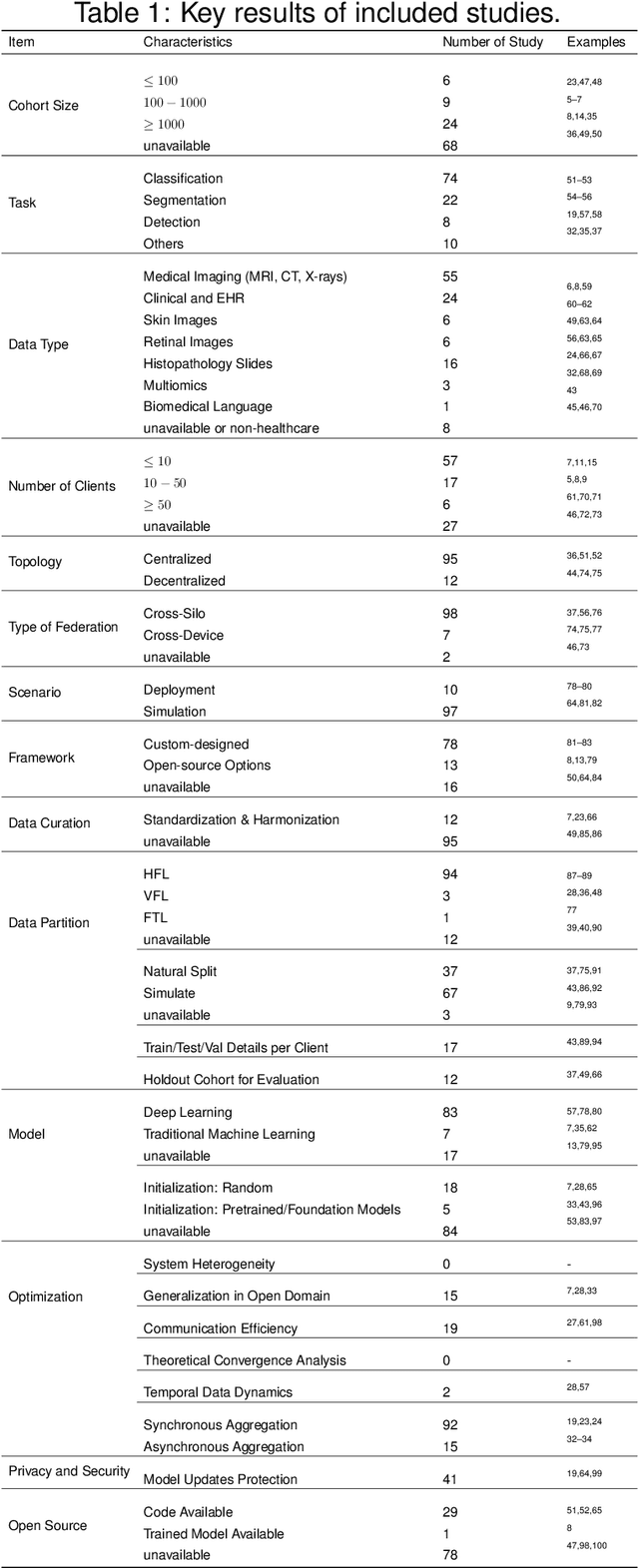
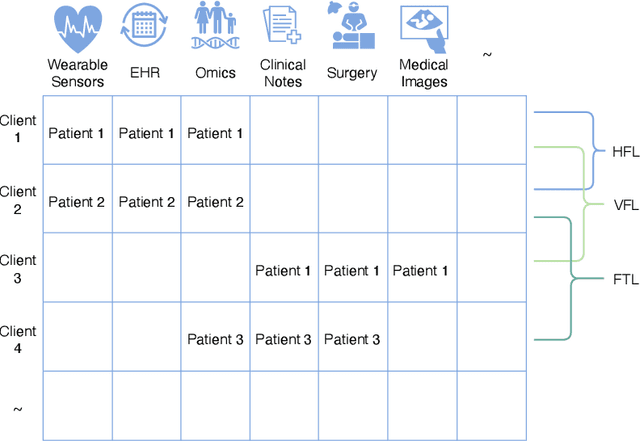

Abstract:Federated learning holds great potential for enabling large-scale healthcare research and collaboration across multiple centres while ensuring data privacy and security are not compromised. Although numerous recent studies suggest or utilize federated learning based methods in healthcare, it remains unclear which ones have potential clinical utility. This review paper considers and analyzes the most recent studies up to May 2024 that describe federated learning based methods in healthcare. After a thorough review, we find that the vast majority are not appropriate for clinical use due to their methodological flaws and/or underlying biases which include but are not limited to privacy concerns, generalization issues, and communication costs. As a result, the effectiveness of federated learning in healthcare is significantly compromised. To overcome these challenges, we provide recommendations and promising opportunities that might be implemented to resolve these problems and improve the quality of model development in federated learning with healthcare.
Detecting and Identifying Selection Structure in Sequential Data
Jun 29, 2024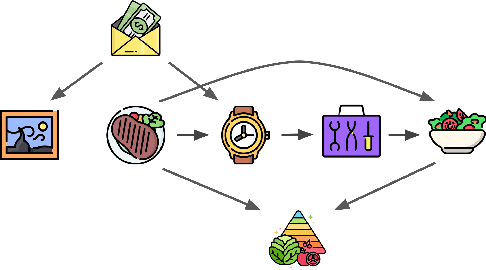



Abstract:We argue that the selective inclusion of data points based on latent objectives is common in practical situations, such as music sequences. Since this selection process often distorts statistical analysis, previous work primarily views it as a bias to be corrected and proposes various methods to mitigate its effect. However, while controlling this bias is crucial, selection also offers an opportunity to provide a deeper insight into the hidden generation process, as it is a fundamental mechanism underlying what we observe. In particular, overlooking selection in sequential data can lead to an incomplete or overcomplicated inductive bias in modeling, such as assuming a universal autoregressive structure for all dependencies. Therefore, rather than merely viewing it as a bias, we explore the causal structure of selection in sequential data to delve deeper into the complete causal process. Specifically, we show that selection structure is identifiable without any parametric assumptions or interventional experiments. Moreover, even in cases where selection variables coexist with latent confounders, we still establish the nonparametric identifiability under appropriate structural conditions. Meanwhile, we also propose a provably correct algorithm to detect and identify selection structures as well as other types of dependencies. The framework has been validated empirically on both synthetic data and real-world music.
Long-Term Fairness Inquiries and Pursuits in Machine Learning: A Survey of Notions, Methods, and Challenges
Jun 10, 2024



Abstract:The widespread integration of Machine Learning systems in daily life, particularly in high-stakes domains, has raised concerns about the fairness implications. While prior works have investigated static fairness measures, recent studies reveal that automated decision-making has long-term implications and that off-the-shelf fairness approaches may not serve the purpose of achieving long-term fairness. Additionally, the existence of feedback loops and the interaction between models and the environment introduces additional complexities that may deviate from the initial fairness goals. In this survey, we review existing literature on long-term fairness from different perspectives and present a taxonomy for long-term fairness studies. We highlight key challenges and consider future research directions, analyzing both current issues and potential further explorations.
Steering LLMs Towards Unbiased Responses: A Causality-Guided Debiasing Framework
Mar 13, 2024



Abstract:Large language models (LLMs) can easily generate biased and discriminative responses. As LLMs tap into consequential decision-making (e.g., hiring and healthcare), it is of crucial importance to develop strategies to mitigate these biases. This paper focuses on social bias, tackling the association between demographic information and LLM outputs. We propose a causality-guided debiasing framework that utilizes causal understandings of (1) the data-generating process of the training corpus fed to LLMs, and (2) the internal reasoning process of LLM inference, to guide the design of prompts for debiasing LLM outputs through selection mechanisms. Our framework unifies existing de-biasing prompting approaches such as inhibitive instructions and in-context contrastive examples, and sheds light on new ways of debiasing by encouraging bias-free reasoning. Our strong empirical performance on real-world datasets demonstrates that our framework provides principled guidelines on debiasing LLM outputs even with only the black-box access.
Hunting imaging biomarkers in pulmonary fibrosis: Benchmarks of the AIIB23 challenge
Dec 21, 2023
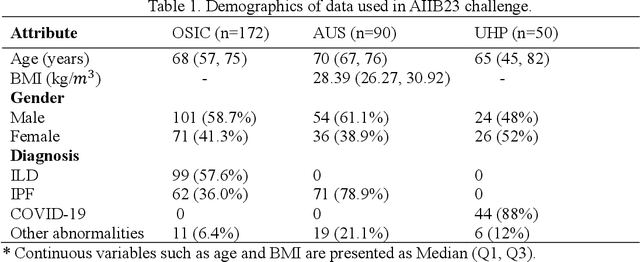
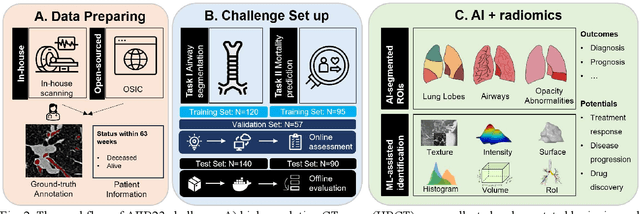
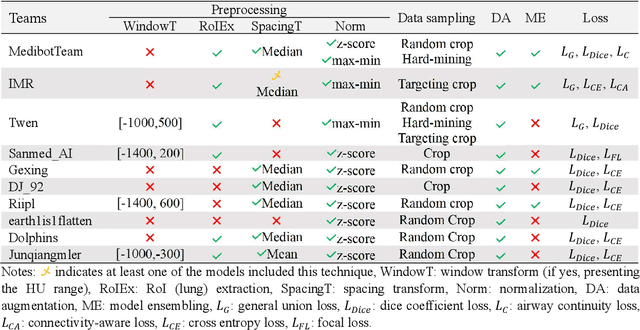
Abstract:Airway-related quantitative imaging biomarkers are crucial for examination, diagnosis, and prognosis in pulmonary diseases. However, the manual delineation of airway trees remains prohibitively time-consuming. While significant efforts have been made towards enhancing airway modelling, current public-available datasets concentrate on lung diseases with moderate morphological variations. The intricate honeycombing patterns present in the lung tissues of fibrotic lung disease patients exacerbate the challenges, often leading to various prediction errors. To address this issue, the 'Airway-Informed Quantitative CT Imaging Biomarker for Fibrotic Lung Disease 2023' (AIIB23) competition was organized in conjunction with the official 2023 International Conference on Medical Image Computing and Computer Assisted Intervention (MICCAI). The airway structures were meticulously annotated by three experienced radiologists. Competitors were encouraged to develop automatic airway segmentation models with high robustness and generalization abilities, followed by exploring the most correlated QIB of mortality prediction. A training set of 120 high-resolution computerised tomography (HRCT) scans were publicly released with expert annotations and mortality status. The online validation set incorporated 52 HRCT scans from patients with fibrotic lung disease and the offline test set included 140 cases from fibrosis and COVID-19 patients. The results have shown that the capacity of extracting airway trees from patients with fibrotic lung disease could be enhanced by introducing voxel-wise weighted general union loss and continuity loss. In addition to the competitive image biomarkers for prognosis, a strong airway-derived biomarker (Hazard ratio>1.5, p<0.0001) was revealed for survival prognostication compared with existing clinical measurements, clinician assessment and AI-based biomarkers.
Tier Balancing: Towards Dynamic Fairness over Underlying Causal Factors
Jan 21, 2023Abstract:The pursuit of long-term fairness involves the interplay between decision-making and the underlying data generating process. In this paper, through causal modeling with a directed acyclic graph (DAG) on the decision-distribution interplay, we investigate the possibility of achieving long-term fairness from a dynamic perspective. We propose Tier Balancing, a technically more challenging but more natural notion to achieve in the context of long-term, dynamic fairness analysis. Different from previous fairness notions that are defined purely on observed variables, our notion goes one step further, capturing behind-the-scenes situation changes on the unobserved latent causal factors that directly carry out the influence from the current decision to the future data distribution. Under the specified dynamics, we prove that in general one cannot achieve the long-term fairness goal only through one-step interventions. Furthermore, in the effort of approaching long-term fairness, we consider the mission of "getting closer to" the long-term fairness goal and present possibility and impossibility results accordingly.
 Add to Chrome
Add to Chrome Add to Firefox
Add to Firefox Add to Edge
Add to Edge